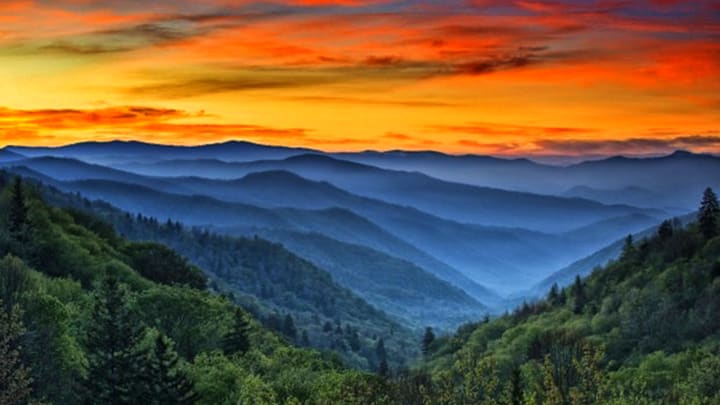If you’ve ever driven through the Blue Ridge Mountain range in Appalachia, you’ve probably seen the hazy hues that sweep across the distant peaks. The colors range from cerulean to robin’s egg blue, creating a picturesque view unlike any other. The further the mountains, the lighter the color, though every distant peak appears to be some shade of blue. Yet when you travel up close to those same mountains, something strange happens. The blue turns to green, and suddenly you find yourself weaving through rhododendron bushes and deciduous trees, puzzled about where the blue hues came from in the first place.
- So, what makes the Blue Ridge Mountains blue?
- Why are they blue instead of, say, red?
- Does this happen anywhere else?
So, what makes the Blue Ridge Mountains blue?
Curious minds have been wondering why the Blue Ridge Mountains are blue for centuries. It turns out that trees are to blame for that phenomenon—or, more specifically, their volatile hydrocarbons are.
When the temperatures rise across the South, trees emit isoprene (a hydrocarbon) to protect themselves from the extreme temperatures. This is essentially what Dutch biologist Frits Warmolt Went theorized in 1964 when he wrote that the color resulted from by the trees’ production of airborne organic compounds. The idea was that the volatile hydrocarbons interact with ozone in the air and appear blue under the sun’s rays. Years later, PBS noted [PDF] that the extreme biodiversity in the region is also partially to blame.
This part of the country happens to have lots of oak trees, which are known to release plenty of isoprene. Comparatively, maple trees produce relatively small amounts of this hydrocarbon. Conifers like spruce and fir trees also emit lots of isoprene. As long as the South hosts lots of isoprene-producing trees like oaks, the mountains will continue to appear blue.

Why are they blue instead of, say, red?
In order to understand why the South doesn’t contain a Red Ridge Mountain range, you have to understand a bit about physics and the way the human eye perceives color. Our retinas responds best to light red, green, and blue hues. Blue hues have shorter wavelengths than other colors, which makes them easy for the eye to detect.
The sun casts a full spectrum of light towards Earth, but the haze over the Blue Ridge Mountains causes those colors to scatter, leaving the human eye to detect the remaining, shorter wavelengths (blue). Scientists determined that smaller molecules like oxygen and nitrogen (which are abundant in Earth’s atmosphere) do a better job of scattering light with shorter wavelengths like blue.
But the Blue Ridge Mountains no longer look as vibrant as they once did. Through pollution, humans have added additional particles into the atmosphere of the region, worsening visibility overall. Over time this has contributed gray hues in addition to the blue ones.
Does this happen anywhere else?
This phenomenon isn’t exclusive to the United States. Australia’s Blue Mountains experience a similar effect, though the eucalyptus tree is largely responsible for the blue hues there. Canada has its own Blue Mountains, and India’s Nilgiri Hills also appear blue from afar. Essentially, with the right number of compound-releasing trees, ozone, and sunlight, any mountain range could adopt a blue tint.
Read More About Nature:
